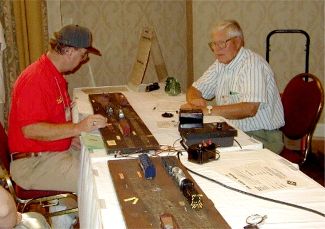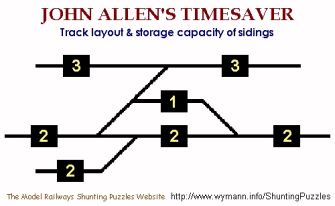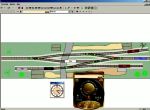Mention “switching puzzles” to a group of model railroaders and the conversation inexorably drifts to the one standard of the genre. There are numerous examples of “Timesaver–like” layouts all over the internet and the magazine press. There are countless examples of scenicked and plain-jane Timesaver clones as well. What other thirty-five year old layout engenders such admiration, nostalgia and amusement?
What is the Timesaver?
Perhaps we should start by explaining what the Timesaver is NOT:
- The Timesaver is NOT a layout design element.
- The Timesaver is NOT a module or domino.
- The Timesaver is NOT designed as a part of a larger layout. Some modelers may incorporate one into a larger layout (I did) but it was not DESIGNED that way.
So then, what did it look like, how was it constructed, how was it played?
The Timesaver is meant to be a puzzle, a game, a diversion. That’s how John Allen designed it. It was intended to be a game to be played after operating sessions on the Gorre and Daphetid, when operators climbed the stairs to John’s kitchen. The game had a simple layout, simple rules, and a complex solution that changed each time it was played.
There was always a small wager (usually a whole nickel, as I recall) between the players, with each trying to predict who would solve the night's puzzle in the quickest time. With John holding the ever–ticking stopwatch, the pressure to find the right moves in the shortest time often lead to language best learned on a battleship or in a foxhole. John’s good-natured ribbing, grunts, and even stage yawns if the time went too long, added to both the enjoyment and the anguish.

For an object of near veneration among model railroaders, this was (and is) one of the plainest, even ugliest, little railroads ever built. It was built primarily from commercial HO scale components mounted on a plain wooden sheet, with no ballast, no scenery, and no buildings. It had a simple toggle switch for operation of the locomotive and an old train controller connected to the end of the board by two unhidden wires provided power and set the speed.
The only unique element in its construction was the use of wye turnouts
for the single runaround. This shortened the length of the board and
reduced the space available for engine and cars to the minimum.
Uncoupling magnets mounted between the rails were the only
“legal” uncoupling points and small cardboard strips marked
the target locations for the cars.
The double Timesaver is shown here at the 2000 PCR Convention with the
late Allan Fenton (right) who was its custodian from the time of John's
death and the fire until he passed away on August 26, 2001.
A video of Allen explaining the rules at the 2000 PCR Convention can be seen
here
.
Some further notes on the Timesaver
The Diagram
Diagrams of the Timesaver are available in many locations on the Internet, but the most accurate (and simplest) is provided at the
Model Railways Shunting Puzzles website. It is reproduced here by permission. This website has additional excellent information on the Timesaver, its construction and operation and many examples of Timesaver clones. It also features the “Inglenook,” a fiendish, simple-looking British switching puzzle with as many devotees as the Timesaver. I highly recommend
Inglenook Sidings to any aficionado of switching puzzles.

Note the single runaround and the explicit lengths of each siding. These were just long enough for the designated number of cars but had no bumpers, so a little extra “oomph” on a pushing move would result in a derailment and time penalty.
The Rules
The rules were equally simple:
- You may not touch any equipment except the toggle switch and the turnout levers.
- Time begins when the timekeeper indicates. “Thinking time” is included in your score.
- Move all cars and the engine from the starting positions to the end positions designated by the markers.
- Only time is counted. Do not count the number of moves.
- There is a time penalty for derailments through closed turnouts, derailments at the end of a spur or touching the equipment, in addition to the time required to rerail the cars and/or locomotive.
- Occasionally the Baker couplers did not couple correctly. Derailments caused by equipment malfunctions do not count.
- This is supposed to be fun. Stop sweating. (Actually, I added that one to represent my own experience.)

 For an object of near veneration among model railroaders, this was (and is) one of the plainest, even ugliest, little railroads ever built. It was built primarily from commercial HO scale components mounted on a plain wooden sheet, with no ballast, no scenery, and no buildings. It had a simple toggle switch for operation of the locomotive and an old train controller connected to the end of the board by two unhidden wires provided power and set the speed.
For an object of near veneration among model railroaders, this was (and is) one of the plainest, even ugliest, little railroads ever built. It was built primarily from commercial HO scale components mounted on a plain wooden sheet, with no ballast, no scenery, and no buildings. It had a simple toggle switch for operation of the locomotive and an old train controller connected to the end of the board by two unhidden wires provided power and set the speed.



